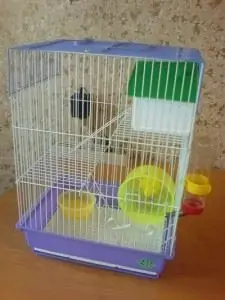- Author Delia Mathews [email protected].
- Public 2023-12-16 00:05.
- Last modified 2025-01-22 15:45.
Hamsters are funny animals for both children and adults. But many do not turn them on because of the unpleasant odor from the cell. And those who have acquired this cute animal try to get rid of the smell by frequent cleaning and chemical detergents. The odor problem can be solved by keeping these fluffy animals properly.

A hamster is a rodent, which means that the cage for it must be iron or plastic. On sale, cages with iron bars and a plastic tray or completely plastic enclosed terrariums are more common. Here, the choice depends on you: filler and feed may fall through the rods, and the plastic may darken and it will not look aesthetically pleasing.
The cage must have a feeder, drinker and wheel. Hamsters learn to drink water from a special drinking bowl themselves, they have an excellent nose for water. Hamsters need a wheel to keep themselves in shape, because these animals are quite active.
The litter in the cage can be different: large sawdust, compressed sawdust pellets, corn pellets. Never lay newspaper, office paper or cotton wool. After all, it depends on the litter how often you have to clean up in the cage. It is recommended to change the litter as it gets dirty. Clean up the toilet once or twice a week. You will notice this corner right away, because the hamsters are clean and only go to one place. After removing this place, pour the old filler from the pallet there, and add fresh filler to the cage. It is not advised to change everything at once, because hamsters react very sharply to change the filler and begin to emit a specific smell for the territory mark.
There is an even more convenient way - this is to put a special toilet for small rodents in the corner. They can be found at any pet store. During the week, observe where your pet goes, and the next time you clean, place the corner toilet over the stool, add some used scent filler. The toilet can be easily removed from the cage and washed in running warm water. Do not use detergents, otherwise your hamster will stop walking to a certain corner and find another place to toilet.
The hamster's resting area should also be cleaned once a week. This is their home, their home corner for storing supplies. When cleaning the house, you need to pull out only those supplies that quickly deteriorate (fresh fruits, vegetables; pieces of cottage cheese, meat and bread). If you are feeding exclusively dry, balanced food, then it is better to clean even less often as an unpleasant smell appears from the house.
The cage itself also needs to be washed periodically. At this time, the hamster is transplanted to a suitable place with half of the old filler. After washing, dry the cage, sprinkle fresh filler mixed with the old one. Transplant the hamster back and watch how the little owner will put his own order there.
As you can see, keeping your hamster clean and odorless is not difficult at all. After all, the more often you wash and clean up the rodents, the stronger they will smell. I wish you pleasant communication with your pets.






